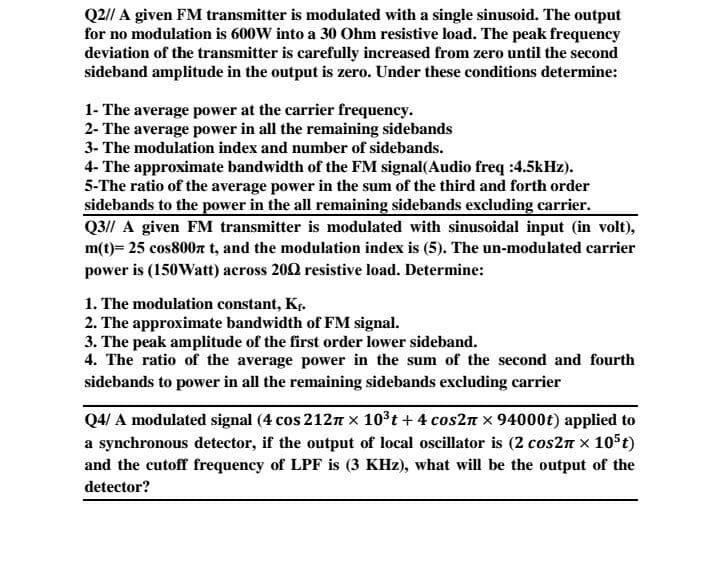A given nsmitter is modu a single sinusoid. The output for no modulation is 600W into a 30 Ohm resistive load. The peak frequency deviation of the transmitter is carefully increased from zero until the second sideband amplitude in the output is zero. Under these conditions determine: 1- The average power at the carrier frequency. 2- The average power in all the remaining sidebands 3- The modulation index and number of sidebands. 4- The approximate bandwidth of the FM signal(Audio freq :4.5kHz). 5-The ratio of the average power in the sum of the third and forth order sidebands to the power in the all remaining sidebands excluding carrier. Q3// A given FM transmitter is modulated with sinusoidal input (in volt), m(t)= 25 cos800n t, and the modulation index is (5). The un-modulated carrier power is (150Watt) across 2002 resistive load. Determine: 1. The modulation constant, Kr. 2. The approximate bandwidth of FM signal. 3. The peak amplitude of the first order lower sideband. 4. The ratio of the average power in the sum of the second and fourth sidebands to power in all the remaining sidebands excluding carrier Q4/ A modulated signal (4 cos 212n × 10³t + 4 cos2n x 94000t) applied to a synchronous detector, if the output of local oscillator is (2 cos2n x 105t) and the cutoff frequency of LPF is (3 KHz), what will be the output of the detector?
A given nsmitter is modu a single sinusoid. The output for no modulation is 600W into a 30 Ohm resistive load. The peak frequency deviation of the transmitter is carefully increased from zero until the second sideband amplitude in the output is zero. Under these conditions determine: 1- The average power at the carrier frequency. 2- The average power in all the remaining sidebands 3- The modulation index and number of sidebands. 4- The approximate bandwidth of the FM signal(Audio freq :4.5kHz). 5-The ratio of the average power in the sum of the third and forth order sidebands to the power in the all remaining sidebands excluding carrier. Q3// A given FM transmitter is modulated with sinusoidal input (in volt), m(t)= 25 cos800n t, and the modulation index is (5). The un-modulated carrier power is (150Watt) across 2002 resistive load. Determine: 1. The modulation constant, Kr. 2. The approximate bandwidth of FM signal. 3. The peak amplitude of the first order lower sideband. 4. The ratio of the average power in the sum of the second and fourth sidebands to power in all the remaining sidebands excluding carrier Q4/ A modulated signal (4 cos 212n × 10³t + 4 cos2n x 94000t) applied to a synchronous detector, if the output of local oscillator is (2 cos2n x 105t) and the cutoff frequency of LPF is (3 KHz), what will be the output of the detector?
Introductory Circuit Analysis (13th Edition)
13th Edition
ISBN:9780133923605
Author:Robert L. Boylestad
Publisher:Robert L. Boylestad
Chapter1: Introduction
Section: Chapter Questions
Problem 1P: Visit your local library (at school or home) and describe the extent to which it provides literature...
Related questions
Question

Transcribed Image Text:Q2// A given FM transmitter is modulated with a single sinusoid. The output
for no modulation is 600W into a 30 Ohm resistive load. The peak frequency
deviation of the transmitter is carefully increased from zero until the second
sideband amplitude in the output is zero. Under these conditions determine:
1- The average power at the carrier frequency.
2- The average power in all the remaining sidebands
3- The modulation index and number of sidebands.
4- The approximate bandwidth of the FM signal(Audio freq :4.5kHz).
5-The ratio of the average power in the sum of the third and forth order
sidebands to the power in the all remaining sidebands excluding carrier.
Q3// A given FM transmitter is modulated with sinusoidal input (in volt),
m(t)= 25 cos800n t, and the modulation index is (5). The un-modulated carrier
power is (150Watt) across 200 resistive load. Determine:
1. The modulation constant, Kr.
2. The approximate bandwidth of FM signal.
3. The peak amplitude of the first order lower sideband.
4. The ratio of the average power in the sum of the second and fourth
sidebands to power in all the remaining sidebands excluding carrier
Q4/ A modulated signal (4 cos 212n x 103t + 4 cos2n x 94000t) applied to
a synchronous detector, if the output of local oscillator is (2 cos2n x 105t)
and the cutoff frequency of LPF is (3 KHz), what will be the output of the
detector?
Expert Solution
This question has been solved!
Explore an expertly crafted, step-by-step solution for a thorough understanding of key concepts.
Step by step
Solved in 7 steps with 7 images

Knowledge Booster
Learn more about
Need a deep-dive on the concept behind this application? Look no further. Learn more about this topic, electrical-engineering and related others by exploring similar questions and additional content below.Recommended textbooks for you

Introductory Circuit Analysis (13th Edition)
Electrical Engineering
ISBN:
9780133923605
Author:
Robert L. Boylestad
Publisher:
PEARSON

Delmar's Standard Textbook Of Electricity
Electrical Engineering
ISBN:
9781337900348
Author:
Stephen L. Herman
Publisher:
Cengage Learning

Programmable Logic Controllers
Electrical Engineering
ISBN:
9780073373843
Author:
Frank D. Petruzella
Publisher:
McGraw-Hill Education

Introductory Circuit Analysis (13th Edition)
Electrical Engineering
ISBN:
9780133923605
Author:
Robert L. Boylestad
Publisher:
PEARSON

Delmar's Standard Textbook Of Electricity
Electrical Engineering
ISBN:
9781337900348
Author:
Stephen L. Herman
Publisher:
Cengage Learning

Programmable Logic Controllers
Electrical Engineering
ISBN:
9780073373843
Author:
Frank D. Petruzella
Publisher:
McGraw-Hill Education

Fundamentals of Electric Circuits
Electrical Engineering
ISBN:
9780078028229
Author:
Charles K Alexander, Matthew Sadiku
Publisher:
McGraw-Hill Education

Electric Circuits. (11th Edition)
Electrical Engineering
ISBN:
9780134746968
Author:
James W. Nilsson, Susan Riedel
Publisher:
PEARSON

Engineering Electromagnetics
Electrical Engineering
ISBN:
9780078028151
Author:
Hayt, William H. (william Hart), Jr, BUCK, John A.
Publisher:
Mcgraw-hill Education,